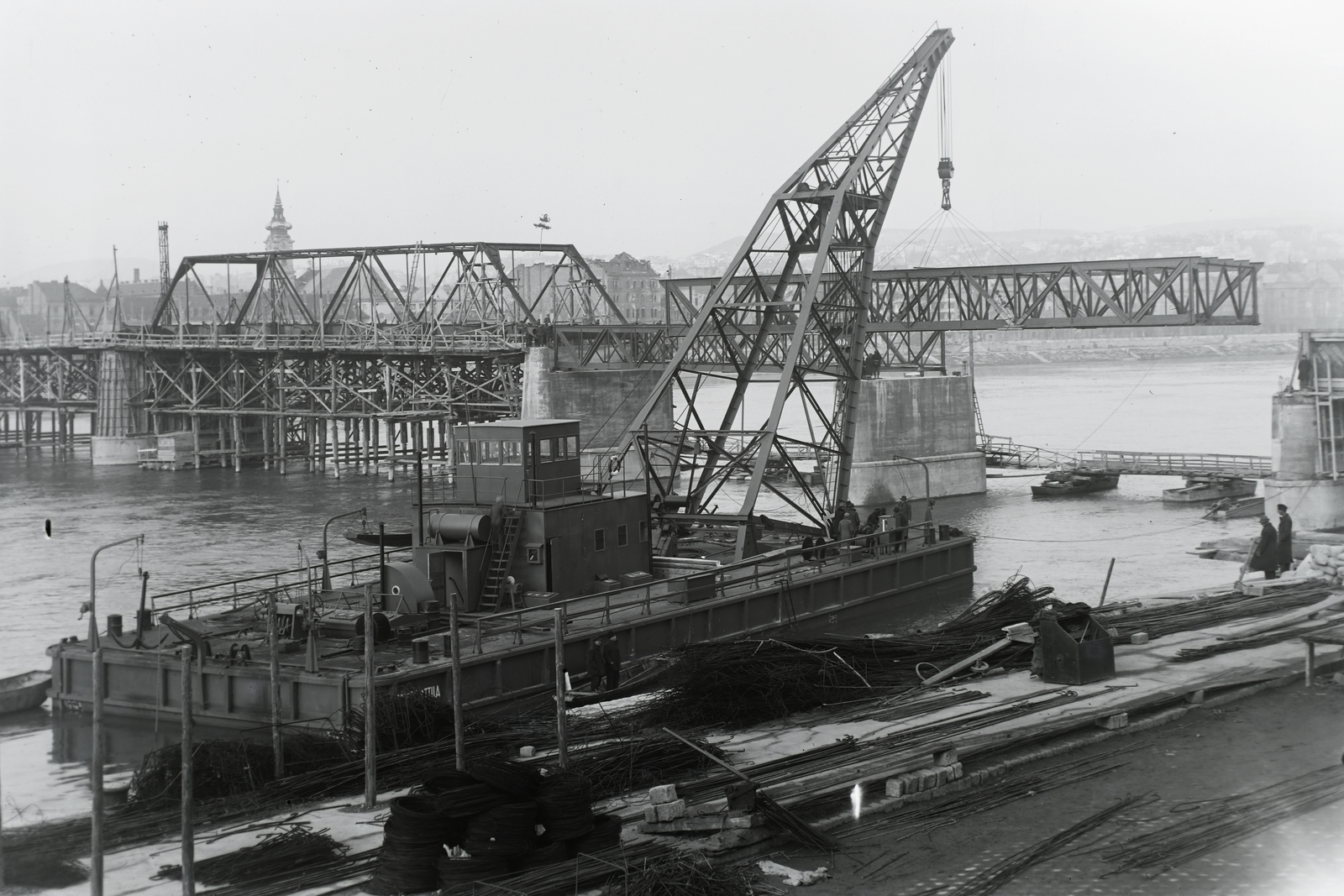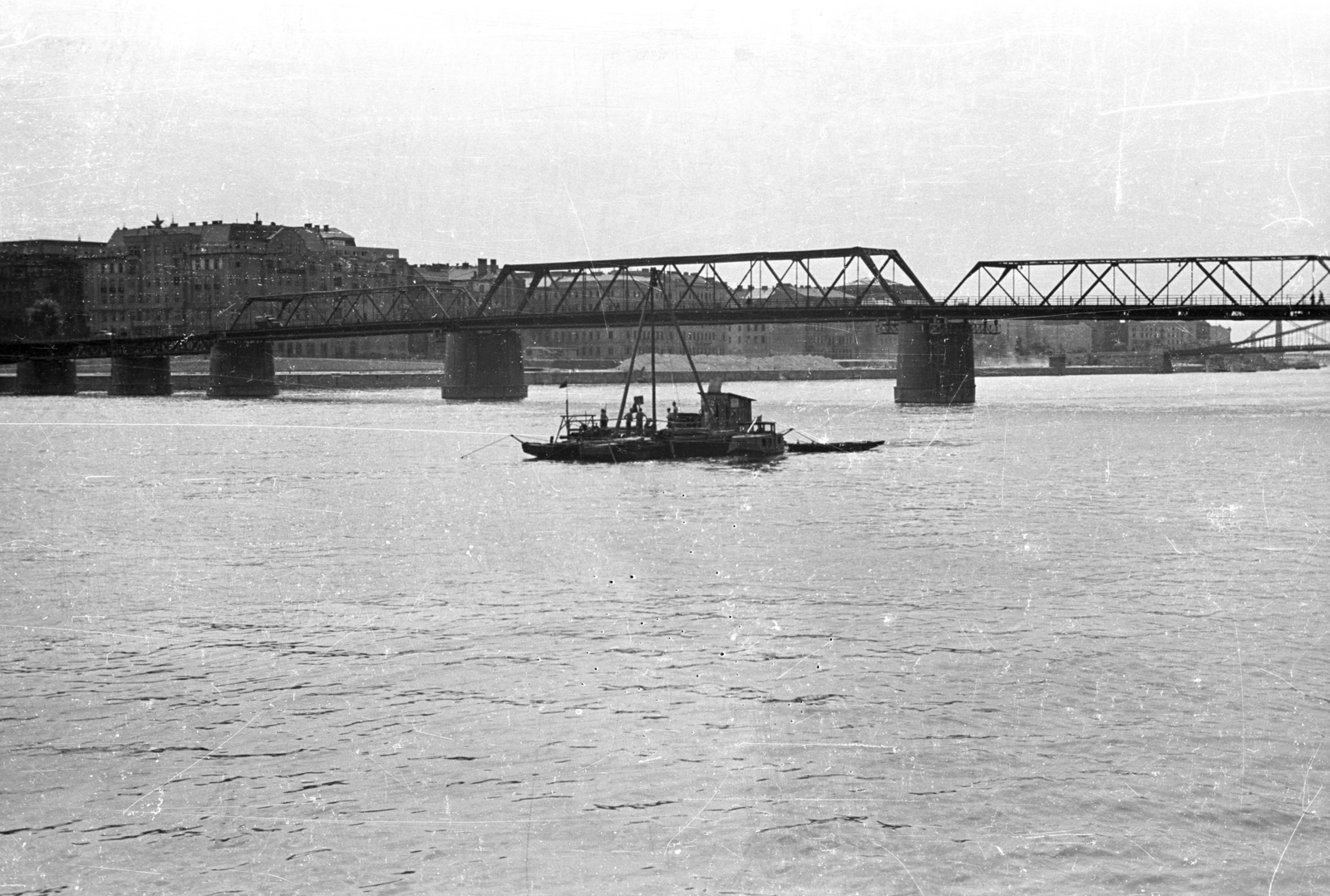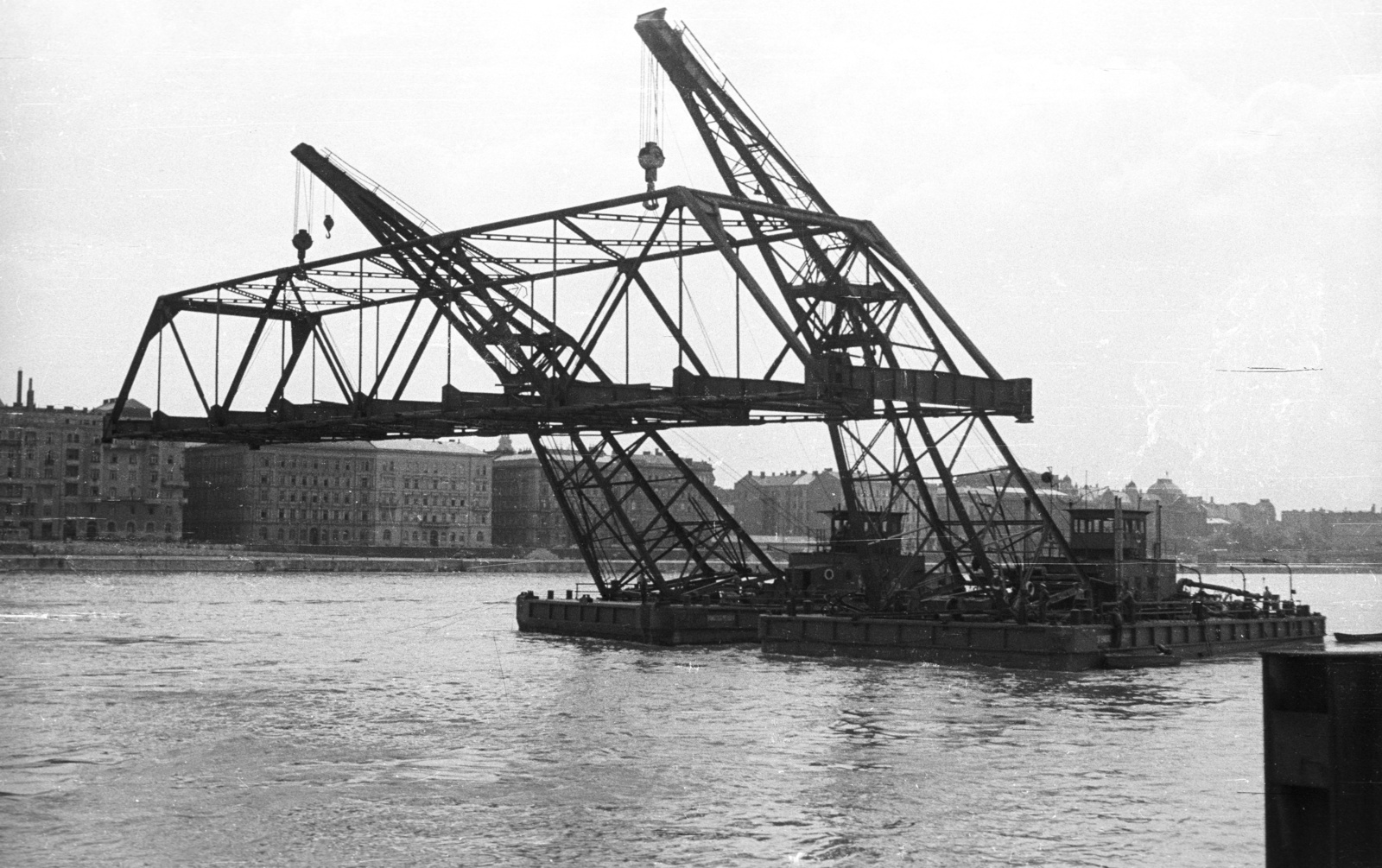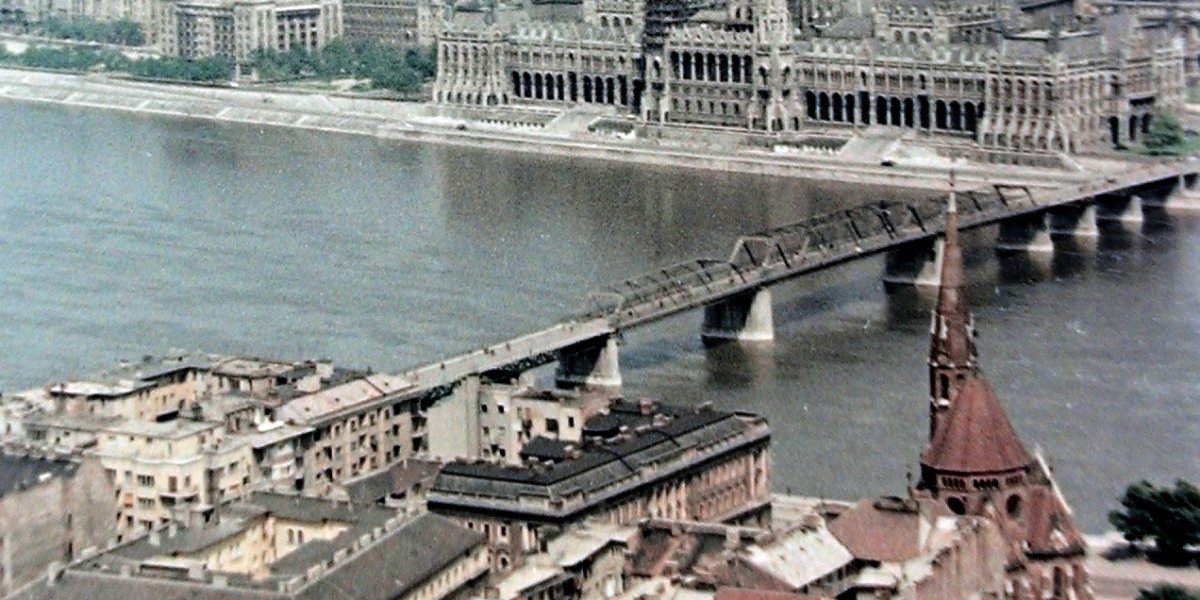After the war, there was practically only one location for a new bridge in Budapest: between Kossuth and Batthyány Squares, as ruins or pontoon bridges blocked all other locations.
Neither aesthetic nor urban planning considerations were raised during the construction of Kossuth Bridge – the only goal was to connect Pest and Buda. Urban planners and developers had talked about a bridge near the Parliament Building since the 1880s, but the idea was rejected. Many feared that the bridge would ruin the view of the Danube bank dominated by the Parliament. Some residents raised similar concerns in connection with Kossuth Bridge – but these were unreasonable at the time.
The bridge was not one designed to withstand centuries of wear. The government earmarked money for constructing a semi-permanent bridge as early as April 1945, and planning could begin.

Construction of Kossuth Bridge from scaffolding and a floating crane (Photo: Fortepan, Hungarian Museum of Technology, Science and Transport/Collection of Historical Photographs/Ganz collection)
The original plans called for a completely wooden bridge, and the possibility of building one with six or nine spans was explored. The number of openings was considered essential because planners feared that a higher number of pillars would be a liability to ice drifts. The scarcity of wood and a lack of knowledge to build such a large wooden bridge in Hungary were also problems.
Fortunately, a sizable amount of steel pipes were found at of Weiss Manfréd Művek, allowing planning to move ahead with a steel frame. The final plans called for a bridge with nine spans. The three larger central ones would be built of steel, and the three outer spans towards either riverbank would be made of wood.
The bridge department prepared the designs in the Ministry of Trade and Transport, led by Endre Mistéth and Elek Hilvert. Károly Széchy, the head of the bridge department supervised the construction.

Aesthetics were not a consideration – a proper connection was more important (Photo: Fortepan/No.: 129205)
The construction had to be completed quickly and in terrible conditions. The route of the bridge was laid out 22 My 1945, and foundation word began in June. However, the project lacked raw materials and manpower. The workers were given food instead of pay. Collecting enough kitchen utensils to cook for the workers in the build sites kitchen was itself a challenge.
The wood and iron needed were obtained in any way possible. The swimming pools on the Danube were demolished because the wood in them was needed for the bridge. When even that wasn’t enough, pines in the gardens of villas in Buda were felled. When the iron sources ran dry, workers scavenged more from the ruins of the other bridges or destroyed buildings.
Eventually, enough iron was found to allow two further spans to be built of metal rather than wood.
The construction was hampered by a flood on the Danube in October 1945, and when the work was nearing completion in January 1946 by severe ice drifts.

The bridge was completed just in time because drift ice destroyed all other temporary bridges just a few days before it was opened
(Photo: Fortepan/UVATERV)
On 9 January 1946, drift ice appeared, which destroyed the Manci Bridge and the temporary structure built on the wreckage of the Franz József Bridge two days later. The link between Buda and Pest was severed, and the new bridge stood unfinished. True, work was almost done – but the Danube showed no mercy. On 12 January a floating platform used for construction was swept away.
When the ice destroyed the temporary bridges on 10 January, Magyar Nemzet wrote:
“After these events, Budapest’s residents lay all their hopes on Kossuth Bridge, where work carries on day and night. According to a report from Wednesday evening, there is a chance that the bridge will be opened to pedestrians on Monday.”
Pedestrians could finally use one of the pavements from 15 January, while the entire bridge was opened on 18 January.
The structure was far from as strong as a usual bridge. It was designed to support trucks weighing 15 tons and 300 kg of load per square metre (instead of the usual 450 kg/sq. m.,). In all 750 tons of steel and 3000 cubic meters of wood were used for the bridge. The roadway was 7 metres wide, with a 3.5-metre pavement on either side.
The bridge was not beautiful: its structure was different in each opening, depending on the material that was scavenged or raise from the depths of the Danube from the ruins o the other bridges at the given stage of construction, Kossuth Bridge resembled the former bridges of Budapest little, at least aesthetically – but this was of little concern. It truly was, as it was often called, the bridge of life. Its “only” role was to create a semi-permanent, safe connection between the two parts of the city, unaffected by the water level of the Danube at least until the destroyed bridges were rebuilt.
Take note that that bridge was built in eight months, with workers powering through colds of -15 degrees, working overtime with barely enough to eat. Most of the vehicles, tools, equipment they would have needed had been lost in the war. (One-hundred years earlier the Chain Bridge had taken ten years to complete, and the shortest bridge in Budapest Szabadság Bridge, was built in 2 years between 1894 and 1896.)

The structure was demolished in 1960 (Photo: Fortepan/No.: 51219)
The circumstances of the construction are illustrated by the Magyar Nemzet issue quoted above also publishing the governments request that the residents of Budapest donate food, clothes and money to the workers on the bridge. The article described the working conditions in detail:
“They work despite being underfed, in torn clothes and worn shoes, defiantly enduring the bitter lack of food and clothing, they face the icy winds. These workers have given up the dreams of sleep, Sunday’s rest, toiled through Christmas and New Year’s Day, and heroically taken accepted the sacrifice that few Hungarian workers have ever made.”
The construction was accelerated – beyond the sacrifices of the workers – by new technologies. The steel structures were built on the shore, the steel elements being welded instead of riveted. The two new floating cranes József Attila and Ady Endre also supported the effort
The Kossuth Bridge served Budapest for nearly ten years. Of course, as a result of the hurried construction, the bridge had many flaws. Welds had to be maintained, and joints strengthened. The four outer wooden spans were replaced with steel structures in 1953. But Kossuth Bridge was never intended to be a permanent structure. The bridge was closed to vehicles in the spring of 1956, and pedestrians could only use it until 1958. The bridge structure was demolished in 1960, and by 1963 the riverbed was also cleaned of the pillars.
Nevertheless, the significance of Kossuth Bridge is difficult to fathom. The builders and designers completed a miracle over the Danube in those eight months. The communist system was not ungrateful. The designer, Endre Mistéth, who, in the coalition period, was a secretary of state as a delegate of the Smallholders Party, and then served as Minister for Reconstruction, and the Minister for Public Work was arrested in 1947 and jailed after a show-trial. He was only released in 1955.
Today, all that immortalises one of the most important bridges that ever stood are two plaques, one of Batthyány Square, another on Kossuth Square.
Cover photo: Kossuth Bridge in 1957 (Photo: Fortepan)





































Hozzászólások
Log in or register to comment!
Login Registration